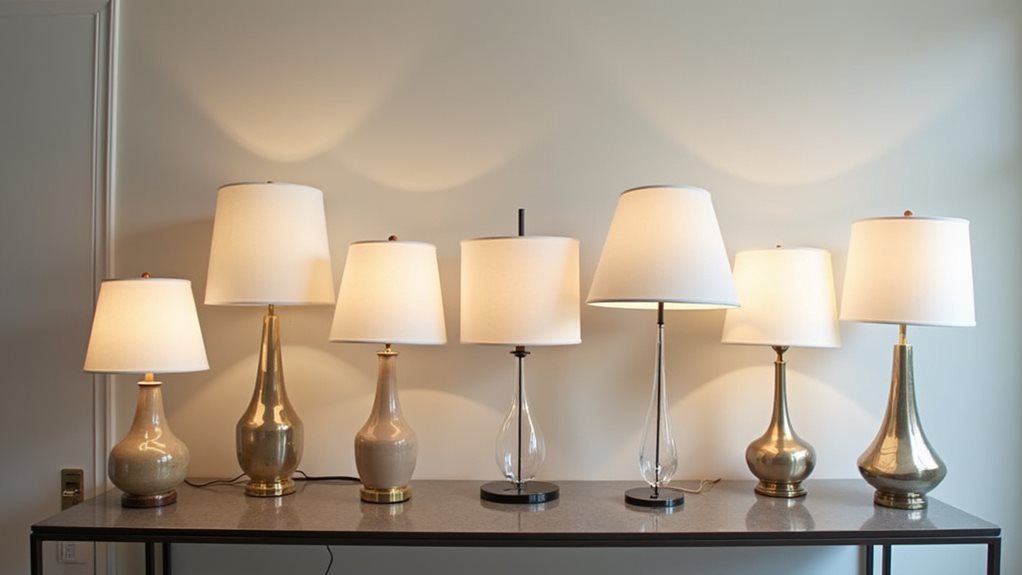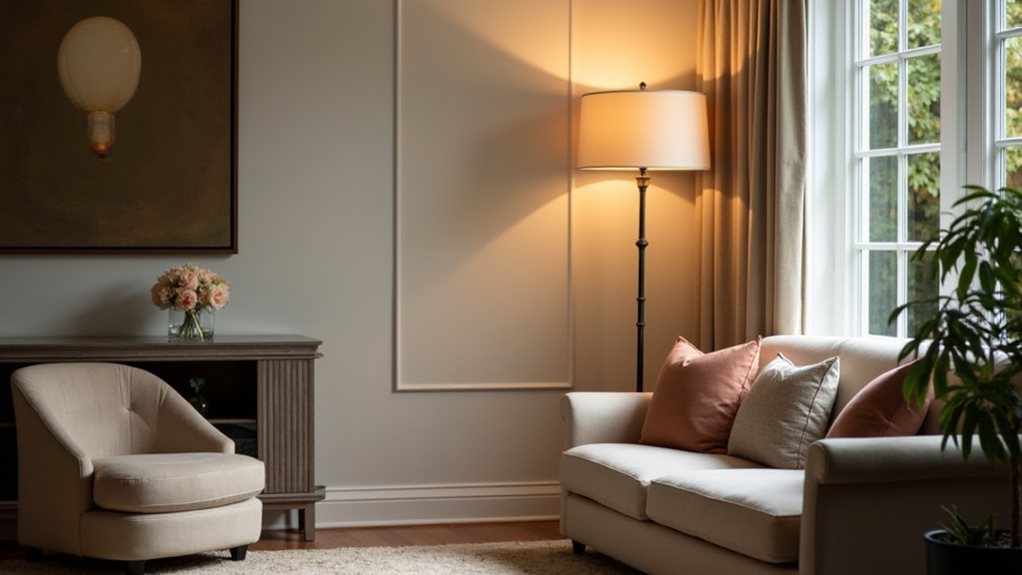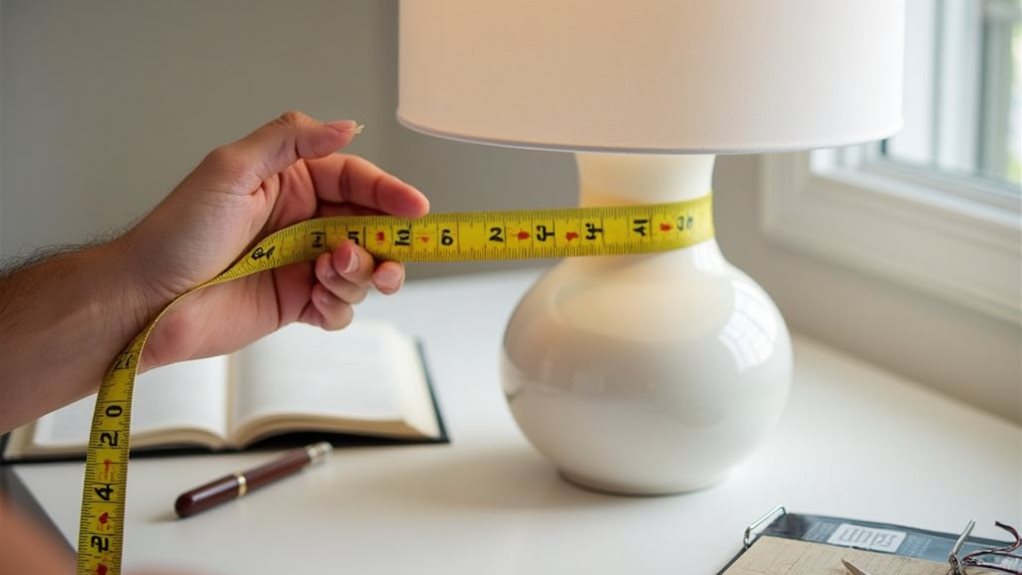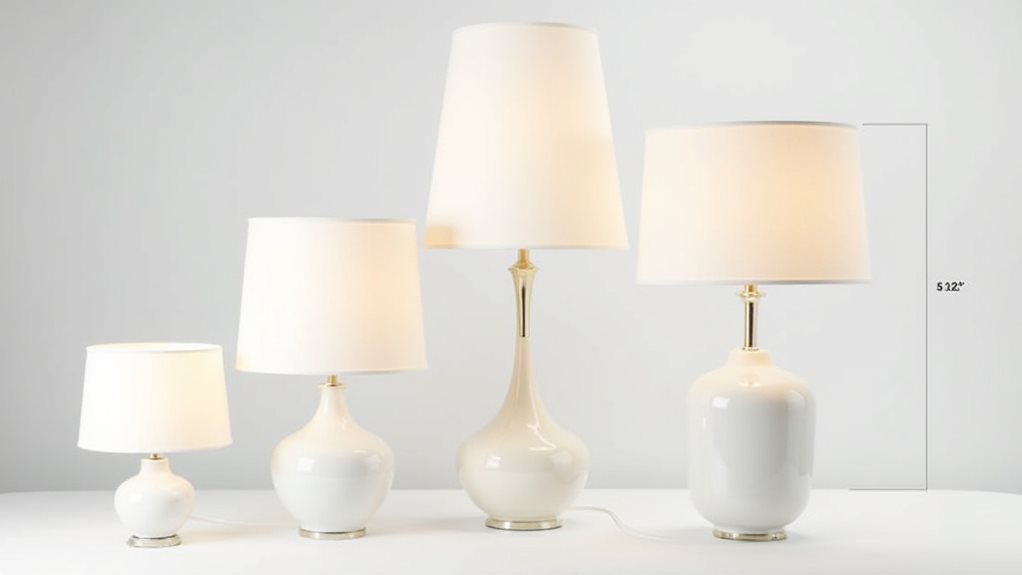Selecting the right lamp shade size involves balancing width and height with the lamp base for a harmonious look. The shade’s diameter should approximately double the base width, while its height is ideally two-thirds the base height. These proportions ensure the shade complements the lamp’s style and function. Consideration of room size, desired ambiance, and safety standards further refines your choice. Exploring material and shape options will tailor the shade perfectly to your decor.
Key Takeaways
- Ensure shade diameter is approximately twice the width of the lamp base for balanced design.
- Shade height should be about two-thirds the height of the lamp base for proportional aesthetics.
- Select shade style and material to complement decor and lamp base for cohesive look.
- Verify heat resistance and UL ratings of shade materials for safety and durability.
- Confirm secure fixture compatibility and adherence to wattage limits for safe, functional use.
Understanding Lamp Shade Dimensions

Before delving into the specifics of lamp shade dimensions, it is crucial to grasp the fundamental elements that contribute to a harmonious and aesthetically pleasing combination of base and shade.
The interplay between the lamp base width and the shade’s diameter is pivotal in achieving design balance. A general guideline suggests that the shade’s diameter should be roughly twice the base width, ensuring that the shade neither overwhelms nor is overshadowed by the base. Ideal shade diameter typically measures between 12 and 16 inches for table lamps, whereas floor lamps may accommodate shades up to 20 inches in diameter, depending on the room’s scale.
This balance is further influenced by the shade’s shape, which can range from traditional round shapes to more contemporary forms such as oval, rounded rectangle, or square, each bringing its unique contribution to the lamp’s overall aesthetic.
Additionally, the material of the shade impacts the texture and feel, adding another layer of consideration in choosing the right shade dimensions that complement the base and contribute to the room’s ambiance. The height of the shade should approximately equal the height of the lamp base from the bottom to the socket, creating a proportional look that is pleasing to the eye.
Selecting the Ideal Shade Height

How does one determine the appropriate height for a lamp shade? The key lies in understanding proportions and the function of the shade.
Ideally, the shade height should be about two-thirds the height of the lamp base, ensuring a balanced look that complements the lamp’s style without overwhelming it. This proportion aids in achieving optimum light distribution, preventing glare by ensuring the bottom of the shade is at or below eye level.
The ideal lamp shade height is roughly two-thirds the lamp base height, ensuring balance, complementing the style, and optimizing light distribution while preventing glare.
However, variations are common, especially when considering different shade styles and the specific impact desired in the room. For instance, floor lamps may accommodate taller shades to create a statement, deviating slightly from the two-thirds rule.
Ultimately, while guidelines provide a starting point, personal judgment and the lamp’s context within the room are crucial in selecting the perfect shade height.
Matching Shade Width to Lamp Base

When selecting the ideal lamp shade width, it’s crucial to consider the proportions in relation to the lamp base to achieve a harmonious balance. A general rule of thumb is to choose a shade width that is approximately twice the diameter of the lamp base, ensuring the shade is wider than the base but not overwhelming.
For table lamps, shades typically range between 12″ and 16″ in diameter, while floor lamps can accommodate larger shades up to 20″ or more for a dramatic effect in spacious rooms.
The width of the shade not only affects the aesthetic appeal but also the light distribution of the lamp. To determine the ideal shade width, measure the widest part of the lamp base, usually at the bottom.
Both the top and bottom diameter of the shade are essential measurements for ensuring a proper fit and enhancing the overall shade design and lamp proportions.
Integrating Style With Measurements

Integrating style with measurements is a crucial aspect of selecting the perfect lamp shade, as it ensures that the shade not only fits well but also enhances the overall aesthetic of the lamp and the room.
Style considerations play a pivotal role in choosing the right shade dimensions. For instance, the height of the shade can significantly influence the visual impact of the lamp, with taller shades making a bold statement, especially in the case of floor lamps.
Moreover, the material of the shade, whether it be fabric for a traditional look or metal for a more industrial feel, should align with the overall decor theme.
Ensuring Safety and Functionality

Beyond the harmonious blend of style and measurements lies the paramount aspect of ensuring safety and functionality when selecting a lamp shade.
It’s crucial to balance aesthetic appeal with practical considerations to guarantee that the lamp not only enhances the decor but also operates safely and efficiently. Here are four key factors to consider:
- Heat Dissipation: Ensure the shade allows adequate ventilation for the bulb to prevent overheating, adhering to UL guidelines for minimum clearance between the bulb and shade.
- Material Compatibility: Choose materials that are heat-resistant and meet safety standards, especially when using high-wattage bulbs.
- UL Ratings and Wattage Limits: Follow the recommended wattage limits for the lamp to prevent electrical hazards, as outlined by UL ratings.
- Fixture Compatibility and Stability: Verify that the shade securely fits the lamp base without compromising the fixture’s stability, ensuring the shade doesn’t overwhelm the base while maintaining a safe distance from the bulb.



Bài viết cùng chủ đề:
Top 5 Small Lamp Shades for Table Lamps
Top 5 Buffet Lamps Set of 2 for Your Home Decor
10 Unique Lamp Shades for Table Lamps to Enhance Your Decor
Top 3 Blue Table Lamps in a Set of 2 for Your Home
10 Extra Large Drum Lamp Shades to Transform Your Space in 2025
Where to Buy Quality Lamp Shades in 2025